Tihāī – तिहाई
Quick Definition: Any phrase which is played 3 times, usually ending on sam with the stroke dha.
Literal Meaning: a third
Example Tihai
The following tihai in tintal (16-beat cycle) uses the phrase tete kata gadi gana dha played 3 times, with a 1-beat pause between each repetition:
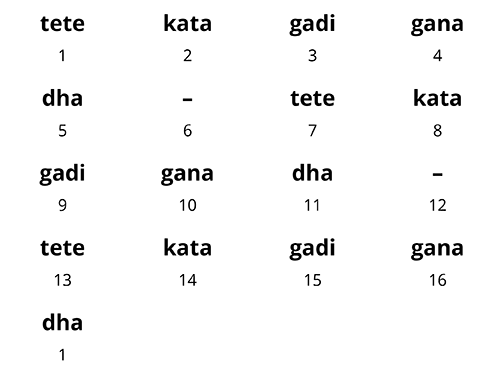
Introduction to Tihai
The tihai is an extremely common form in the Northern classical tradition, and one of the easiest to understand:
A tihai is any phrase that is played 3 times in a row. In most cases, the phrase will end in dha and finish on sam, the 1 of the cycle.
Tihais are strongly cadential, builing up to the sam (the 1 of the tal). Occasionally they will end just before sam (anagat tihai) or just after sam (atit tihai).
Although the tihai form is simple, there are many kinds of tihais in classical tabla, from short and simple to long and complex. And the phrases, patterns, and styles used to create tihais are practically limitless.
Here are a few examples:
- A single-stroke phrase such as dha played 3 times: dha dha dha
- A simple 5-beat phrase such as the example above: (tete kata gadi gana dha) x3
- A much longer and more complex form such as the chakradar, which repeats an entire composition, including a tihai, 3 times. These forms might be 65, 81, or 129 beats long (or longer!).
You will hear tihais on both sides of the music, in melody and percussion. In tabla performance, tihais are commonly used to end improvisations. Tihais are also included in other forms, such as the tukra, uthan, paran, and mukhra-mohra.
Below we will look at the most common kinds of tihais, including other traditional forms which use tihais in their structures.
Damdar Tihai
The most common kinds of tihai are characterized by whether or not there is a pause (rest) between the three repetitions.
When there is a pause, it is called damdar (दमदार). Dam (दम) means "breath" or "moment". So damdar can be translated as "possessing breath".
Damdar Tihai in Tintal
The example tihai at the beginning of this section is a damdar tihai in tintal (16-beat cycle) with a one-beat pause between each repetition:
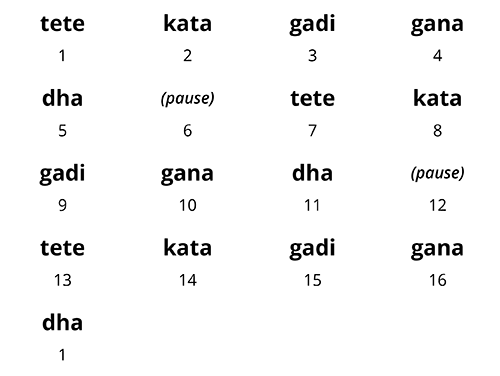
Listen again to this tihai with a metronome throughout:
Damdar Tihai in Jhaptal
Here is a damdar tihai in jhaptal (10-beat cycle):
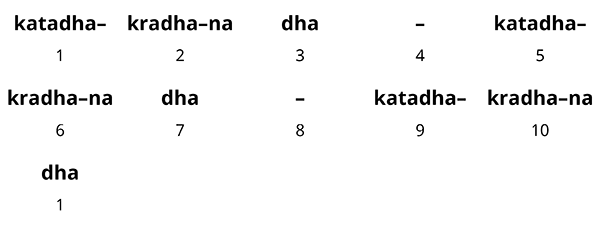
Listen to this tihai: [demonstration coming]
Damdar Tihai in Ektal
And here is the same phrase from the jhaptal tihai above, but now played in ektal (12-beat cycle). Notice the pause is now 2 beats instead of 1:
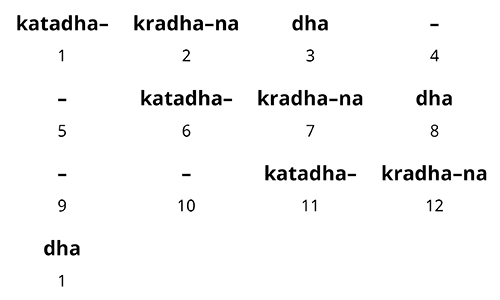
Listen to this tihai: [demonstration coming]
Bedam Tihai
Where there is no pause between the repetitions, or a very short pause, it is called bedam (बेदम). Bedam means “without breath”.
Below is an example of a bedam tihai that is similar to the first example above. It uses the phrase dhage tete kata gadi gana dha played 3 times but with no pause:

Performed with Lahra:
Here is another bedam tihai in tintal, played at 4x-speed (4 strokes per beat). Notice there is a quarter-beat pause between each repetition. At this speed, a quarter-beat pause between repetitions is still commonly considered bedam:
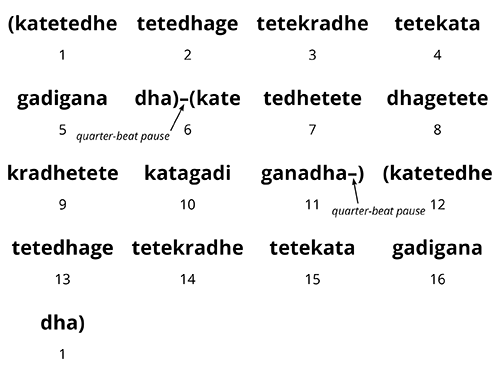
Performed with Lahra:
You might ask, what the minimum pause length to be called a damdar tihai? Answers may vary, but it may depend on the speed or, as in the example above, on how long one considers the stroke dha to last.
Because dha is a resonant stroke, some people would say dha lasts for half of the beat, so there is no gap at all.
Nauhakka
Nau is the Hindi word for “nine”. And a nauhakka (नैहक्का) is a tihai which has 9 repetitions ending in dha, with the last dha falling on sam.
Below is a nauhakka tihai made from the phrase kateteginatidha. In this case, the phrase is grouped into 3 groups of 3 (3 x 3 = 9), with a 1/4-matra pause in between:

Tintal Nauhakka Demonstration
(from Benares Nauhakka 1)
Nauhakka or Chakradar?
Some people believe that a nauhakka tihai must be bedam (no pause), or that there must be equal rests between all 9 repetitions, or that it must end and begin on sam (the 1). According to these requirements, the nauhakka above would be a simple chakradar tihai (discussed below) and not a nauhakka because it does not have equal rests.
Others, including Chhotelal Misra, feel that the only requirement is 9 repetitions ending in dha. This means that the above nauhakka is acceptable, and that damdar (with pause) nauhakkas are also acceptable.
Whatever your definition, most players will feel any nauhakka as a chakradar. They will naturally group the 9 repetitions into 3 groups of 3, whether they are evenly spaced or not.
Below is another nauhakka in jhaptal (10-beat cycle) with uneven rests between repetitions. This clearly feels like 3 groups of 3 and might be called a chakradar tihai in some traditions:

Jhaptal Damdar Nauhakka Demonstration
(from Jhaptal – Benares Nauhakka 1)
In the tintal nauhakka below, all 9 repetitions are evenly spaced. Notice that it begins on the 4th beat of tintal (beats 1–3 are from the tintal theka):

But here too, most players will feel this as 3 groups of 3. In the following demonstration, notice that Rajneesh gives a little more stress to the 3rd, 6th, and 9th dhas of the tihai:
(from Benares Nauhakka 5)
Chakradar Tihai
A chakradar tihai is a structure which has a tihai within a tihai. In other words, a tihai which is played 3 times.
This could be a simple tihai played three times such as the nauhakka we saw above. But more commonly, a chakradar tihai will have the chakradar tukra structure: a tukra-type structure (opening + tihai) which is played 3 times. (The chakradar structure is covered in depth in the Chakradar section.)
Below is a simple chakradar example. Each repetition of this chakradar starts with the opening phrase tirakita takata– followed by the tihai (tirakita dhati dha x3):

Performed 1 time
Performed with Theka and Lahra
(from Benares Mukra 4.2)
Listening to Tihais
Below are compositions from DigiTabla’s Compositions section which include tihais.
The following theme-and-variation compositions all include tihais at the end of their variations sections:
- kayda
- rela
- bant
- gat-kayda
And the following cadential forms contain tihais in their structures:
- nauhakka
- tukra
- chakradar
- uthan
- paran
Tabla students might also be interested in the Common Tihai Forms for the 5 major tals.
References
Kippen, James. The Tabla of Lucknow – A Cultural Analysis of a Musical Tradition. Cambridge: Cambridge University Press, 1988.
Misra, Chhote Lal. Playing Techniques of Tabla – Banaras Gharana. New Delhi: Kanishka Publishers, 2007.
—. Tal Prabandh. New Delhi: Kanishka Publishers, 2006. (Hindi)
Naimpalli, Sadanand. Theory and Practice of Tabla. Mumbai: Popular Prakashan Pvt. Ltd., 2005.
Stewart, Rebecca Marie. The Tabla in Perspective. Unpublished Ph.D. thesis, University of California, Los Angeles, 1974.